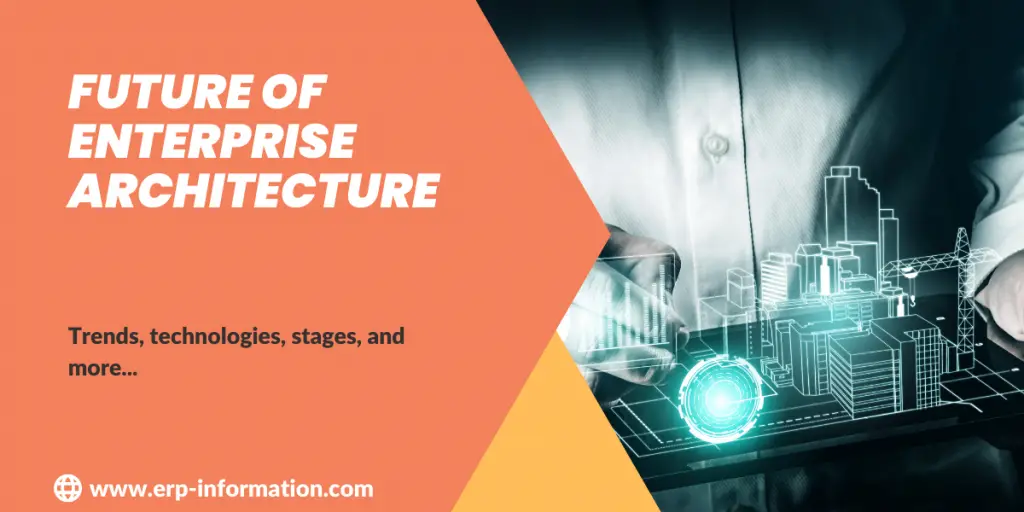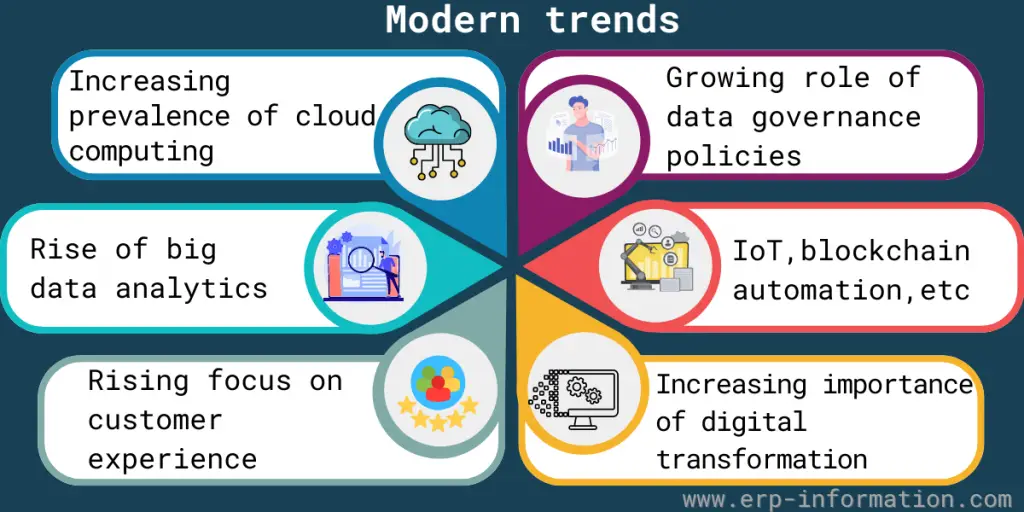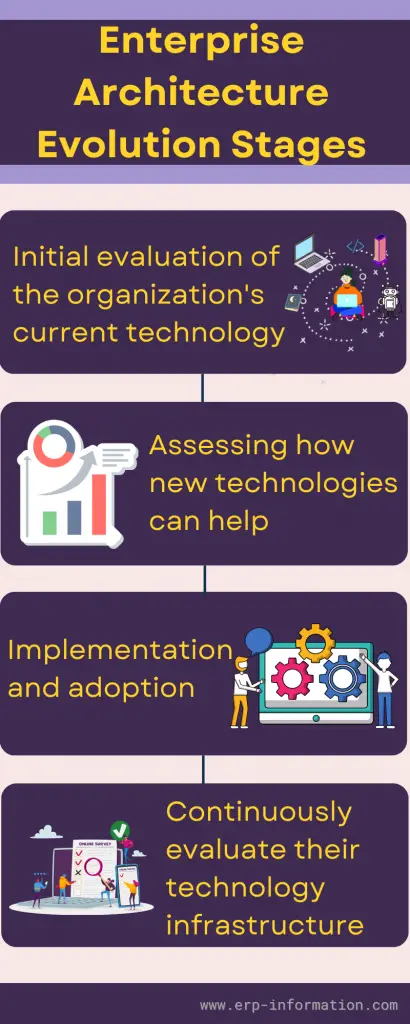As technology advances, enterprise architecture must advance with it.
Many businesses struggle to keep up with the ever-changing needs of their customers and employees. Often, this leads to a disjointed architecture that can’t keep up with the company’s demands.
This blog post will discuss how modern trends and technologies will impact the future of enterprise architecture, the stages of EA evolution, and best practices to ensure future growth.
Enterprise Architecture
Enterprise architecture (EA) is the process of designing and planning your business’ information technology infrastructure.
Using EA, you can ensure that your company has a solid foundation to build future growth. With the right EA tools and team in place, you can confidently make changes to your business without worrying about the impact on your IT infrastructure.
Enterprise Architecture Future Trends
Here we are listing trends that impact the future of enterprise architecture.
1. Cloud computing and SaaS
The first trend likely to impact the future of enterprise architecture is the increasing prevalence of cloud computing and software-as-a-service (SaaS) solutions.
As more businesses adopt these technologies, they can take advantage of a wide range of capabilities offered by modern software solutions, including improved connectivity, scalability, and automation.
That can help enterprises streamline their operations and improve flexibility in responding to changing market conditions.
2. Big data analytics and Artificial intelligence (AI)
A second trend impacting an organization’s architecture is the rise of big data analytics and artificial intelligence (AI).
With the growth of internet-connected devices and large volumes of data being generated daily, organizations are increasingly adopting these technologies to process vast amounts of information and gain valuable insights about customers, markets, and trends.
That can help enterprises become more agile in adapting to changing business needs and growing competition in their industry.
3. Focus on customer experience across industries
A third factor that may shape the future of EA is the rising focus on customer experience across all industries.
As consumers become more demanding and empowered through online platforms, companies are placing greater emphasis on delivering personalized experiences that meet individualized needs and expectations.
To effectively manage this complex landscape, enterprises will need to leverage architecture tools that allow them to understand customer dynamics across multiple channels better and adapt quickly to changes in consumer behavior.
4. Organizational digital transformation
Another trend shaping an enterprise’s architecture is the increasing importance of organizational digital transformation initiatives.
5. Use of IoT, blockchain, and automation
Many businesses are embracing new technologies, such as the Internet of Things (IoT), blockchain, automation, robotics, etc., to improve their competitiveness or strengthen their core operations through digital means.
To capitalize on these opportunities effectively, enterprises will need robust architectures with highly integrated IT systems and processes that support ongoing innovation efforts across all areas of their organization.
6. Growing role of data governance policies
Finally, one key factor likely to influence the future direction of EA is the growing role of data governance policies within organizations today.
Modern Technologies that Impact the Future of Enterprise Architecture
Following are some technologies that affect the future of enterprise architecture.
Augmented reality
With the emergence of augmented reality technologies, such as virtual and mixed reality, enterprises have new opportunities to improve collaboration, productivity, efficiency, and decision-making by integrating real-world and digital data.
Virtual reality
Virtual reality (VR) technology allows users to experience and interact with an immersive simulated environment.
It can help businesses analyze complex processes, train employees, and improve customer engagement through more interactive and immersive experiences.
Autonomous vehicles
Autonomous vehicles have the potential to revolutionize supply chains and logistics by improving efficiency and reducing costs.
That can require significant changes to business architecture, as organizations must invest in new technologies and IT systems to support the real-time monitoring and management of autonomous vehicle fleets.
Mobile computing
With the growth of mobile devices, EA is increasingly becoming more mobile-friendly.
So businesses must design their systems to be easily accessible from any device and anywhere.
Internet of Things
The growth of Internet-connected devices is having a significant impact on EA.
Businesses must architect their systems to communicate with these devices and collect data from them.
Machine learning
Machine learning allows businesses to train computers to learn and improve independently without human intervention.
That can be extremely valuable for businesses that want to use AI but do not have the workforce or resources to do so manually.
Blockchain
The blockchain allows parties to transact directly without intermediaries, reducing costs and improving efficiency.
Businesses must architect their systems to securely send data over this network in real-time.
Enterprise Architecture Evolution Stages
There are several different stages that EA can go through as it evolves. These can include things like
1. Evaluation of the organization’s current technology
The first stage is the initial evaluation of the organization’s existing technology infrastructure to identify areas for improvement and opportunities for growth.
That typically involves a review of existing hardware and software systems, as well as an assessment of end-user needs and expectations.
2. Assessing how new technologies help
During the second stage, organizations work to align their EA modernization efforts with broader business goals and objectives.
That often involves assessing how new technologies can help increase efficiency, improve customer engagement, or enable greater collaboration across the organization.
3. Implementation and adoption
The third stage focuses on implementation and adoption. That includes establishing governance structures and processes that ensure new systems are rolled out on time while providing ongoing support to end users throughout the transition process.
4. Continuous evaluation of the organization’s technology infrastructure
4. Finally, organizations should continuously evaluate their technology infrastructure over time to ensure that it remains up-to-date and aligned with evolving business needs and trends in the marketplace.
That often involves leveraging data analytics tools to track user behavior and measure performance so that issues can be quickly resolved before impacting business operations significantly.
Best Practices to Ensure Future Evolution
Enterprise architecture (EA) plays a vital role in aligning various components to achieve a business’s objectives. In today’s rapidly evolving scenario, it is important for businesses to be adaptable and flexible in their EA strategy.
Here are some simple yet effective practices to ensure your EA evolves and meets the growing needs of your business.
Engage with your stakeholders
Actively listen to your employees and customers to understand their challenges and gather feedback for enhancing the user-friendliness of your EA.
Keep your IT team updated
Provide regular training to your IT staff to keep them abreast of the latest technological trends. This enables them to develop solutions that align with your EA strategy.
Adopt the new
Leverage technologies like big data analytics and machine learning to gain valuable insights. Also, improve your EA for smarter decision-making.
Future-Proof your architecture
Develop clear strategies for incorporating upcoming trends into your architectural framework. Try to stay ahead of industry changes, and remain competitive.
Nurture internal collaboration
Seek input from business leaders, IT staff, and other users to identify areas that need improvement within your current setup.
Stay informed
Continuously monitor external trends that may impact your business or its technology, including industry shifts, competitor activities, and regulatory changes.
Encourage innovation
Create an environment of open communication and innovation. Make people comfortable to share ideas and experiment with new solutions.
These above practices can help your EA remain adaptable, responsive, and aligned with the evolving needs of your business.
FAQs
What is the future role of the Enterprise Architect?
As businesses continue to grow and evolve, enterprise architects must be forward-thinking and agile to keep up with new trends and technologies.
They will also need strong collaboration and communication skills to work effectively with IT teams, product owners, and business stakeholders.
By staying at the forefront of emerging trends and technologies, enterprise architects can help lead their businesses into a bright and profitable future.
What are some important technologies that will affect how enterprise architecture works in the future?
Some important technologies that will change how enterprise architecture works in the future include:
Edge computing: Edge computing is like having computers and data storage closer to where the information comes from. This can make things work faster for businesses.
5G: 5G is the next level of wireless technology. It is good for enterprise architecture because it is really fast, has less delay, and connects a lot of things.
Extended reality (XR): XR means virtual reality (VR), augmented reality (AR), and mixed reality (MR). These technologies could make a big difference in how businesses use software in the future.
How can people who work on enterprise architecture get ready for what’s coming?
People who work on enterprise architecture can get ready for the future by doing the following:
Keep learning about new trends and technologies.
Really understand what their company needs.
Make enterprise architectures that can change and grow and are safe.
Work closely with others to make sure that the way the company works and the enterprise architecture fit together well.
What are some of the unique challenges that businesses will face when implementing EA in the future?
In the future, businesses will encounter special difficulties when setting up EA. By understanding the future of EA, we can prepare for these unique challenges ahead. Some of them are:
1. Embracing New Technologies: Keeping up with fast-evolving technologies like AI, ML, and blockchain will be crucial. Businesses will have to figure out how to incorporate these innovations into their existing EA systems.
2. Safeguarding Data: As businesses gather and analyze more data, safeguarding it from cyber threats will become a significant concern. EA teams will need to create and implement secure EA solutions.
3. Keeping Pace with Change: The business landscape is constantly changing. EA teams will need to adapt and learn continuously, as well as be open to trying out new technologies and strategies to stay relevant in this ever-shifting environment.
Conclusion
The future of enterprise architecture is constantly evolving and changing. So, businesses must architect their systems to allow them to take advantage of the latest technologies.
By doing so, they can future-proof their architectures and stay ahead of the competition.


